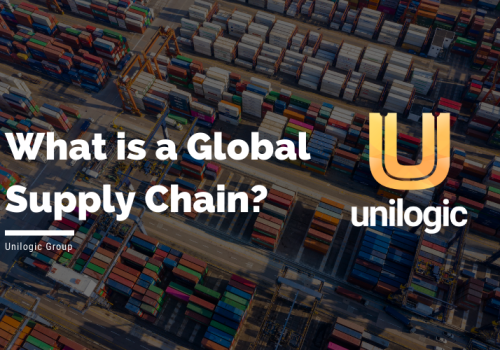What is a Global Supply Chain?

Global Supply Chain Logistics is a term used in business today to describe all activities associated with moving goods and services from suppliers and raw materials handlers to customers and end-users.
This involves coordinating the internal logistical operations of an organization with those of outside vendors, carriers, distributors, and other partners involved in doing business with the company. From
Supply Chain to Successful Global Supply Chain
Successful global supply chains must be able to quickly adjust in response to changes in demand, sales cycles, and market shifts. Logistical coordination across the entire supply chain is imperative to ensure quick reaction times, accurate delivery of goods and services, low cost, efficient use of resources, and high-quality products.
Everything begins with understanding what goods a firm offers, where they originate, and how they will be distributed. This data may be discovered by looking at the company’s master production schedule (MPS), which details the whole manufacturing strategy for all products produced or sold by the firm over time.
This report is a collection of statistics regarding machine usage, jobs, and performance over time. It includes estimates for essential raw materials required, labor needs, job completion dates, beginning dates for new jobs, and production levels forecasted at various phases of manufacturing.
Inventory tracking software is often used to help track and manage product progress. This information can then be shared with procurement, sales, and marketing teams and with external business partners such as suppliers and distributors.
Complications & Solutions of the Global Supply Chain Industry
Establishing a baseline of expected delivery times for all items produced by the firm is the next stage in global supply chain logistics. The demands of consumers are assessed, lead times are estimated, and transportation plans for each carrier utilized are developed.
Because of various requirements for customs documents, special services, and so on, international shipping is a particularly difficult component of global supply chains. These goals must be met without disrupting normal production routines or relying on expensive overtime labor charges that may result from miscalculating workloads or equipment capabilities.
To avoid unexpected disruptions in production, inventory or backlogs of finished goods, raw materials, and work in progress should be closely watched. The purchasing department is in charge of all purchases and services, which the company requires.
The next stage is to employ a reputable agent or representative who can ensure quality control at all supplier/manufacturer locations across the world. In this stage, negotiations with suppliers for lower prices, better product features, and so on must also take place.
Distribution Is A Key Part Of The Global Supply Chain
The final stage in global supply chain logistics is distribution planning, which examines how products will move from where they are created or stored to where they will be required for distribution and sales. It may entail planning for direct delivery from a supplier to a distribution center, from a manufacturer to a distributor or customer location, or for freight via a common carrier.
Buying your goods is only one piece of the food chain. Distribution may include making arrangements for pick-and-pack services, warehousing and storage, and vehicle maintenance. Then it arrives at the transportation department, where procurement officials manage all external source agreements and acquire the necessary transport equipment such as trucks, railway cars, and so on, as well as keeping track of any required spare parts.
Lean & Six Sigma
Global supply chain logistics can be improved by using best practices such as “Lean and Six Sigma” which are methods used globally by companies to reduce waste in production processes, increase customer satisfaction and lower costs.
Lean focuses on creating value for customers while eliminating wasteful processes that do not add value or that create problems. Lean promotes the idea that employees closest to each process know how to improve it and their suggestions for improvement should be sought out.
Six Sigma is a set of data-driven methods used to analyze processes to find ways to eliminate errors or defects. It often involves training employees at all levels of an organization to take responsibility for identifying common causes of problems which can then be eliminated by implementing standard practice changes.
Best Practices in the Global Supply Chain System
Global integration helps companies see themselves as one unit instead of separate business units, increasing market share while providing customers with better service.
One of the most effective tools in supply chain logistics is Best Practices. Although they are costly, some advantages include improved quality control, faster order processing times, lower costs due to more efficient processes, and lastly greater client happiness.
Increased sales and reduced inventory levels, resulting in lower working capital, are common outcomes for a company that follows Best Practices correctly.
Best practices are not unique to a certain sector and may be used in any industry. When it comes to product development procedures, some best practices include using value stream mapping methods to depict each process on a map using icons to identify major stages of production (e.g., design, procurement, etc.).
These maps show the flow of products through the chain and indicate areas for improvement. The best methods for eliminating these bottlenecks include improving communication between departments at a company, such as the purchasing department, which can generate purchase orders that don’t match manufacturing needs, causing delays in production time owing to parts shortages.
To discover your finest practices, an organization must first identify any flaws with present procedures, calculate the costs of delays, and assess client satisfaction. This will provide a good indication of where your firm is currently losing money or time, allowing you to figure out how it might most efficiently utilize its resources in the future.
What Is the Difference Between Global Supply Chain vs Local Supply Chain?
Low-cost country sourcing refers to the acquisition of goods and services from countries with lower labor rates and manufacturing costs than those of one’s nation.
A global supply chain will generally flow from your own company in your home nation as a buyer to your supplier tiers in other countries; these suppliers will be located throughout the world.
A local supply chain will seek to optimize suppliers that are close to your business, in some cases, companies will look for “homegrown” supply chains. Why?
It’s worth noting that a supplier who will be feeding into your supply chain can only place goods on sale in the country where your company is based, or the supply chain may be even closer to your business and possibly within the same state/city/district. This often gives clearer visibility of the whole supply chain from raw material through to the consumer.
Benefits of The Global Supply Chain System
Supply chain management is the process of managing a company’s materials and services as they are sent from one endpoint to the other, throughout a global supply chain. It aims to lower or eliminate unnecessary activities in the production process, resulting in increased efficiency.
Large multinational businesses have a difficult time integrating global supply chain logistics due to the prohibitive expense of doing so. Small firms, on the other hand, can join if they have enough cash set aside for projects like the construction of new warehouses or the employment of foreign labor.
The main advantage of worldwide supply chain logistics is the money it can save a firm if it changes its operations to fit the new system. Using a shipping container that is designed to be readily transferred from one mode of transportation to another, for example, allows for faster and less expensive transport times.
Unilogic and Global Supply Chains
With alliances all over the world, Unilogic Group enhances its competitiveness in today’s market by investing time and money in order to provide better customer service, high-quality goods at lower costs, and greater earnings. Contact us today for more information.
Excepteur sint occaecat cupidatat non proident, sunt in quis officia deserunt mollit anim id est laborum. Sed ut perspiciatis unde omnis iste natus error sit voluptatem accusantium doloremque laudantium, totam rem aperiam, eaques ipsa quae ab illo inventore veritatis et quasi architecto beatae vitae dicta sunt explicabo. Nemo enim ipsam voluptatem quia voluptas sit aspernatur aut odit aut fugit, sed quia consequuntur magni dolores eos qui ratione voluptatem sequi nesciunt. Neque porro quisquam est, qui dolorem. Duis aute irure of dolor in reprehenderit in voluptate velit esse cillum dolore eu fugiat nulla pariatur.
Excepteur sint occaecat cupidatat non proident, sunt in culpa qui officia deserunt mollit anim id est laboru. Sed ut perspiciatis unde omnis iste natus error sit voluptatem accusantium doloremque laudantium, totam rem the aperiam, eaque ipsa ab illo inventore veritatis et quasi architecto beatae vitae dicta explicabo.
Nemo enim ipsam of voluptatem quia voluptas sit aspernatur aut odit aut fugit, sed quia consequuntur magni dolores eos qui ratione voluptatem.
Sed ut perspiciatis unde omnis iste natus error sit voluptatem accusantium doloremque laudantium, totam rem the aperiam, eaque ipsa ab illo inventore veritatis et quasi architecto beatae vitae dicta explicabo. Nemo enim ipsam of voluptatem quia voluptas sit aspernatur aut odit aut fugit, sed quia consequuntur magni dolores eos qui ratione voluptatem.

